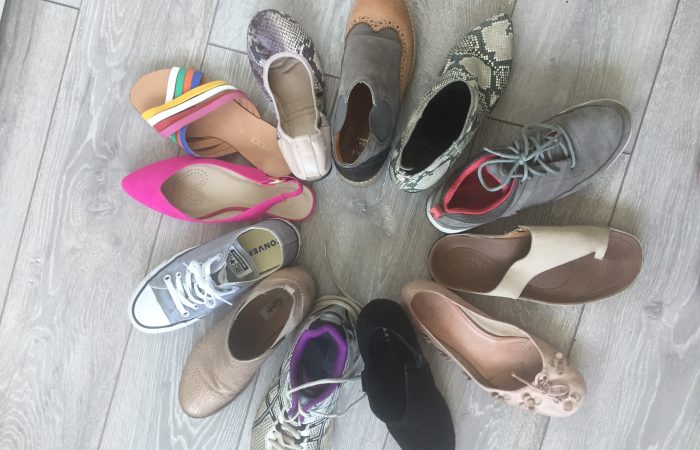
Footwear can give podiatrists an insight to possible causes of foot problems and indeed help to resolve some foot health issues.
Footwear must be fit for purpose and fit.
Which may seem a very obvious point. Wear the correct shoes for the activity being undertaken, for example: trainers for sport, cushioning and support if the activity involves extended time on your feet. Although as adults our feet are no longer growing, it is still important to have a little room between the end of the longest toe and the end of the shoe – this allows for extension of the foot in action and possible increase of size due to swelling/fluid retention. Similarly consideration should be given to the width in relation to foot shape and type. A simple tool for assessing foot size and shape in respect of a particular shoe is to take an outline of the foot and one of the shoe and compare the two, there should be no foot template showing outside of the shoe… A good shoe is foot shaped, feet vary in shape and size, not every shoe style will suit / fit every foot shape.


When purchasing it is worth paying attention to the materials used in the construction, leather shoes tend to have longevity and will, with wear mould to the foot shape. Some modern fabrics have wicking properties, particularly useful in sports wear and for those who are prone to sweaty feet. Cheaper man made fabrics may not remain aesthetic for long, and promote moisture retention, which in turn harbour fungus (causing athlete’s foot). Shoe hygiene is a consideration, and there are a number of products available to address the build up of sweat and smell, as well as antifungal preparations. Some modern shoes are even machine washable.
Talking style…
Fashion along with budget has a huge bearing on footwear choices. That being the case, what makes a good shoe?
- Foot shaped, a shoe which is not competing against the natural shape of the wearers foot, will be more comfortable, no need to be broken in and give rise to fewer corns, calluses and deformities.
- Fastenings, buckles, laces, Velcro or at least a high elasticated front interface, will hold the foot in the shoe. Very much like wearing a seatbelt in a car. In slip on pumps the foot is kept on the shoe as a result of two functional mechanisms both of which in the long term result in conditions requiring Podiatry treatment.
- Snug fit, crowding the toes in a small space….
- Clawing/gripping, the toes work in an attempt to hold the shoe on, often the cause of claw and hammer toes.
The shoe detective…
The wear and tear of a well-worn shoe can give the wearer and the clinician clues as to the way the lower limb and foot are working.
Uneven wear at the heel shows the position at which the foot/shoe strikes the ground during walking.
Distortion Of the upper in relation to the sole can show the professional a number of functional abnormalities that may benefit from biomechanical assessment and intervention. Similarly, evidence of fit can be assessed from the molding of the upper over bony prominences and observing the foot imprint on the integral insole.
The pattern of wear, spirals can show abnormal phases within walking, which give rise to pain and lesions and may be improved or resolved with orthotics.
The new shoe…
Whilst a well-fitting shoe should never need to be broken in, it may be advisable to wear for short but increasing periods initially, to allow the materials to ‘give’, to avoid blisters and allow acclimatisation of the new pair.
Limo shoes…
So-called because they are only worn to get from the car to the red carpet… these are truly unsuitable footwear and purely for appearances! Towering heels and skimpy straps – if you must have them, avoid weight-bearing or walking and kick them off under the table as soon as possible!

